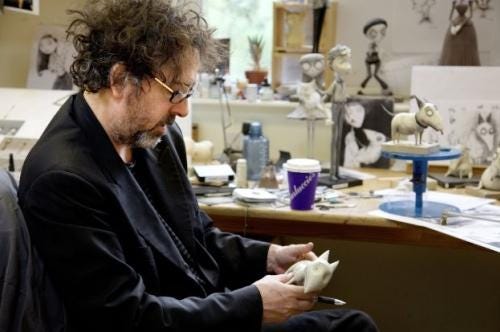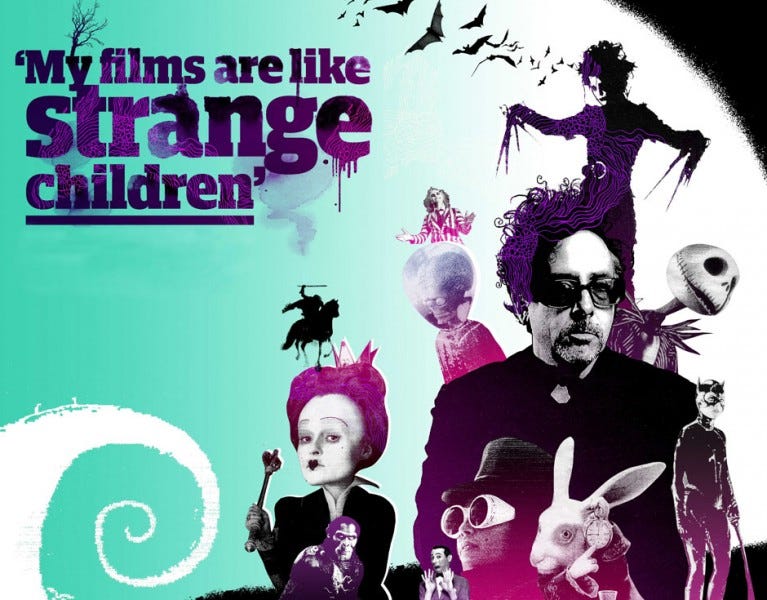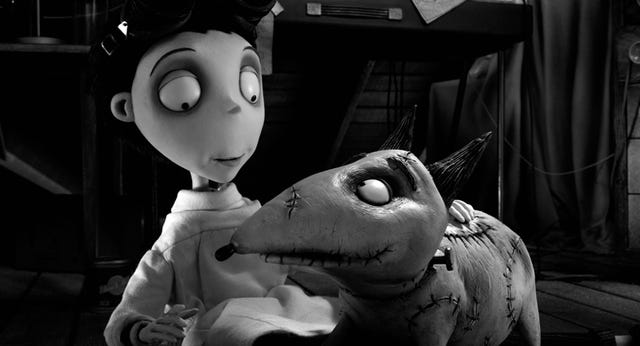The Burton Binge: A Boy and His Dog

Frankenweenie. Edward Scissorhands. Jack Skellington, the Pumpkin King. These fictitious characters sound otherworldly yet they share DNA with their human creator — Tim Burton. With his films, Burton proves that all ideas and characters, no matter how outlandish, are inherently personal. His compulsion to create stems from his childhood desire to see the world as a bigger place, to explore the depths he was restrained from as a boy and comment on that constraint. Burton uses his characters as vehicles to expose the harsh realities beneath their fantastical surroundings and, in turn, our own.
As noted in the book "Burton on Burton," the filmmaker was born a stranger in a strange land. A moody, introverted boy, he felt alienated by the candy-colored artificiality of his home in Burbank, California. Desperate to shed his suburban veneer, Burton indulged in monster movies and the morbid work of writer Edgar Allan Poe.

For Burton, immersing himself in these macabre tales was an act of rebellion.
“Growing up, I guess it was a reaction against a very puritanical, bureaucratic, fifties nuclear environment — me resisting seeing things laid out, exactly as they were. That’s why I think I’ve always liked the idea of fairy tales or folk tales because they’re symbolic of something else” (as Burton is quoted in "Burton on Burton").
Burton related to the monsters in these fantasy yarns to the degree that he wanted to be part of their fictitious worlds.
“I wanted to be the actor who played Godzilla. I enjoyed those movies and the idea of venting anger on such a grand scale. Because I was quiet, because I was not demonstrative in any way, those films were my form of release. I was against society from the beginning” (qtd. in "Burton on Burton").
The creative desires that surfaced later in Burton’s life seem to stem from this need for catharsis — a need that was rarely quenched during his childhood. Despite a preference for fantasy worlds, Burton could not engage in the real world even if he wanted to; his parents protected him from it.
“When I was younger, I had these two windows in my room, nice windows that looked out on the lawn and for some reason, my parents walled them up and gave me this little slit of a window that I had to climb on a desk to see out of. So I likened that to a Poe story where a man was walled in and buried alive” (qtd. in "Burton on Burton").
Burton liberated himself through drawing — an arena in which his nonconformist sensibility could manifest itself freely.
“I didn’t care if I couldn’t make the human form look like the human form. I didn’t care if people liked it. There was this almost drug-induced sense of freedom in drawing” (qtd. in "Burton on Burton").
In 1976, when he was 18, Burton’s artistic talents earned him a scholarship to attend Cal Arts and receive training from Disney Studio animators. He went on to work as an animator for Disney three years later. Despite working in the kind of creative environment he always desired, Burton felt the same societal constraint from his childhood.
“What’s odd about Disney is that they want you to be an artist, but at the same time they want you to be a zombie factory worker and have no personality” (qtd. in "Burton on Burton").
Working at Disney was a taste of bittersweet irony for Burton.
“I felt like a trapped princess. I had a great life in a way. I was able to draw anything I wanted, but it was like working in this completely sealed environment in which you could never see the light of day” (qtd. in "Burton on Burton").
Burton tapped into that feeling with his animated short film, "Vincent" — the dark tale of a boy, like himself, who seeks refuge from his suburban malaise. Watching the film is like witnessing Burton’s childhood unfold before your eyes. Despite its quirky nature, the world of the film feels lived in and achingly real. The main character even looks like Burton, with his sunken eyes and perpetual bed-head.
Personal projects like "Vincent" fueled Burton and inspired him to continue fighting the repression brought on by Disney. However, that is not to say he was restrained all the time. His peers, as well as moviegoers, have responded to his creations rather favorably for the most part. Therefore, like many of his characters, Burton is an outsider who is more tolerated than he thinks he is.
Lately, he seems to be losing the very edge that initially deemed him an outcast. His films are now far less audacious and surprising — recognizable, expected strokes rather than splashes of graffiti. For an artist who claims to be against the norms of society, Burton has grown awfully mainstream.
Although many filmmakers develop a signature style and evoke familiarity in their audience, few have seen diminishing returns or been criticized quite like Burton.

While it may not seem to quell audiences' been-there-done-that attitude, Burton's upcoming "Frankenweenie" remake feels like a step in the right direction. The tale of a boy and his undead dog, this film may help Burton, as it enables the aging filmmaker to look through a child's eyes again and possibly find the creative spark that inspired him to dazzle moviegoers in the first place.
Until "Frankenweenie's" October 5 release, I will look back at all of Burton's films, tracing the return to his roots — and hopefully the revival of his career. Stay tuned next week as I will discuss his first feature-length film, "Pee-Wee's Big Adventure."


